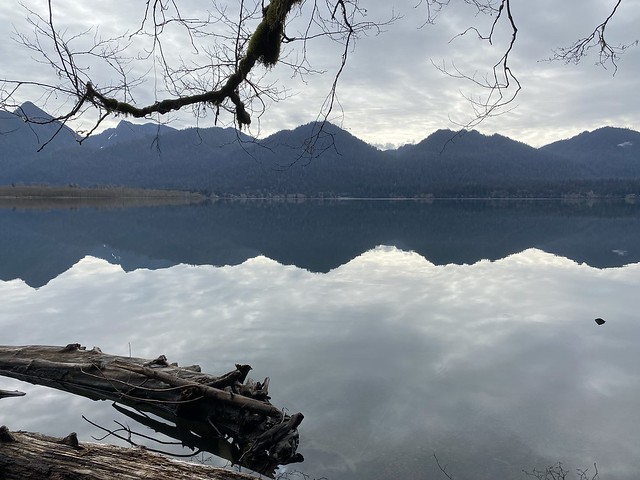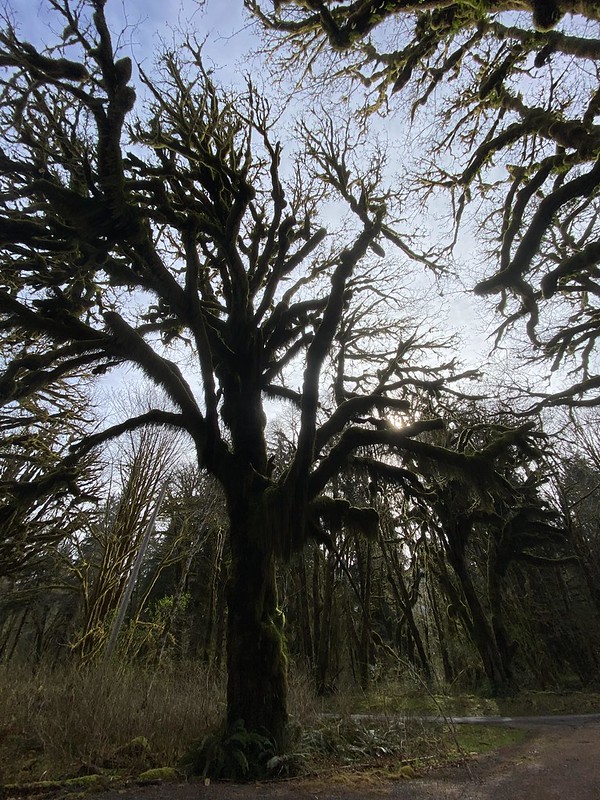The more I visit the Olympic National Park, the more I consider it one of the forgotten National Parks, especially visiting Lake Quinault during the late winter/early spring. Compared to other popular parks, the Olympic NP is a sprawling, untamed wilderness, barely eeked back from the devouring rainforest every season.
Lake Quinault experiences its own challenges, with lakeshores that may be four feet underwater during the spring melt. The tree giants withstand catastrophic wind storms, saturated soil, droughts, and (gasp) tourists. For months out of the year, snow and rain don’t just keep visitors at bay – but park rangers and maintenance personnel as well.
During the summer months, the lush green rainforest will explode. Giant conifers will persist through the dry season feeding off of nurse logs that hold on to water, soaked up like a sponge during the winter. Ferns, mushrooms, and huckleberries will shelter under the vast canopies. The damages of the winter will be erased by tireless park rangers, only to rinse and repeat every single summer.
To get to Lake Quinault, you have to drive around the wild interior of the Olympic Penninsula. Via the north, you may pass by the Lake Crescent area of the Olympic National Park. Around the south side, you may drive through small farming communities until you turn north into vast acres of forests, some clear cut. As you approach the Lake, your cell phone signal starts getting weaker. Roadside services become harder and harder to find.
Check out our part one and (future) part two videos on our Youtube Channel:
Where to Stay at Lake Quinault
When visiting the Lake Quinault area of the Olympic National Park, you may choose to camp or lodge. During the winter season, many of the campgrounds are closed, but during the summer you may reserve campsites right on the waters of the lake. During the winter, some of these sites could be underwater!
There are two major lodging options: the historic Lake Quinault Lodge, and the Rainforest Resort Village.
We stayed at the historic lodge, which though bears the name of the park, is not operated by the Olympic National Park. After turning on the South Shore Drive from the highway, the Lodge is only a few miles away. The Lodge was constructed in 1926, over the span of 10 weeks, for a cost of $90,000. Several additional buildings were added over time, creating a massive resort. The rooms are comfortable and clean, but basic.
The Rainforest Resort Village sits near the northern end of the Lake on South Shore Drive, a few miles past the Lodge. Offerings include cabins, an Inn, suites, and an RV Campground. Technically, the largest Sitka Spruce resides on the Rainforest Resort Village property.
Food Options in the Quinault Rainforest
If you plan to visit the Quinault Rainforest on a budget, plan to bring food with you. There are options for markets and convenience stores where you can find some staples, such as hamburger buns and instant noodles.
There are several dining options in the area offering great food… for a price. Some of the best options near the Lake include the Roosevelt Dining Room, the Salmon House, and the Internet Cafe.
The Roosevelt Dining Room is located inside the Lake Quinault Lodge. The restaurant got its name after Franklin Roosevelt ate there during his tour of the Olympic Penninsula. The dining room offers locally inspired and historic recipes, such as the Roosevelt pot roast, or roasted duck breast with root vegetables. We found every single dish to be delectable, even though expensive ($30-40 per plate).
The more moderately priced Salmon House offers plenty of salmon dinners. Options include Broiled Salmon or Blackened Salmon, with sides such as rice pilaf or baked potatoes. We thought the food was solid and the portions generous for the price ($18-30 per plate). However, the dishes were a little light on flavor/seasoning.
The Internet Cafe is located in the nearby town of Amanda Park. You may set up a laptop while enjoying coffee or a meal. The diner-style restaurant offers hearty breakfasts and lunches but closes early in the afternoon. The meals were affordable and wholesome ($10-20). We also took sandwiches to-go with us to eat on a hike. We appreciated that they were wrapped in foil instead of single-use cling film.
Exploring Lake Quinault and the Quinault Valley
During the winter/spring, the cooler temperatures around the lake limit the water recreation that you might find during the summer. However, there are plenty of trails in the area to explore creeks, waterfalls, rainforest fauna, and giant trees.
Rainforest Loop Trail
Across the road from the Lake Quinault Lodge, the Rainforest Loop trail connects with other branches of trails. You can choose a short 1-2 mile loop, or take a longer route for 5-6 miles. A trail follows the shore of the lake, where you may scramble over huge logs, deposited by the winter tides. Deeper in the rainforest, you can enjoy a few of the Cascade Falls, or the Cedar Bog.
On the Rainforest Nature Loop trail, signs provide information about the plants and creatures living in the rainforest, and marvel at the 10-20′ diameter trees. You may hear about the largest Douglas Fir in the world, at about 19.2′ in diameter. This tree is located up an unimproved trail. We opted not to trailblaze, quite happy with the (slightly) smaller cousins on the Nature Loop Trail.
Valley of the Giants
Before it fell over in 2016, Lake Quinault was also home to the largest Western Red Cedar. While researching things to see and do around the lake, this map of the Valley of Giants kept popping up. The directions noted that the trailhead was across from the Lake Quinault resort, which appears to no longer exist.
However, we found the trail, which was unmarked, and ventured up the trail, baffled by how unmaintained it was. As we scrambled over fallen trees and rotten bridges, we mused if perhaps the giant tree had blown over. Unfortunately, the traffic of tourists exploring the tree caused the roots to become unstable, and the tree fell during a major wind storm. Despite its demise, we marveled over the size of its remains, walking across the trunk, 20′ off of the ground.
However, the largest Sitka Spruce is very easy to find. Parking by the Rainforest Resort Village’s convenience store, a short trail brings you to the tree. This tree isn’t particularly taller than other trees around but is staggeringly large in diameter.
Kestner Homestead Trail/Maple Glade Trail
At the Lake Quinault Ranger Station, you can start on two different trails, the Kestner Homestead Trail and the Maple Glade Trails. These trails are flat, well-graded, and easy to manage.
The Kestner Homestead is now a collection of dilapidated buildings. We were surprised that you could get so close to rusted trucks and leaning structures in the middle of a national park. However, the rest of the trail offers views of marshland, swollen creeks, and even a pretty little plant called a skunk cabbage. Along this trail, you see reminders of the rainforest, such as moss-covered trees and ferns.
While you’re out exploring, keep an eye out for Roosevelt Elk, deer, and other wildlife. Also, take a few minutes to stop at Merriman Falls and snap a couple of pictures.





Looks like the perfect weekend getaway! I will definitely keep in mind your advice once I get the chance to visit this place. Thank you for sharing such an informative and great article 🙂
Hope the info helps for when you can get out there!
Thanks for the trip home. I grew up in Forks and this was, quite literally, my backyard growing up.
I’m glad I could share our experience with you!!! 🙂
It all looks so gorgeous! I’d love to visit WA sometime. If we do, we’ll definitely take a trip here!!
Looks like a gorgeous place for a weekend getaway! Thank you for sharing!
GORGEOUS! We love backpacking and are always looking for new places to go. Would love to go here someday! 🙂